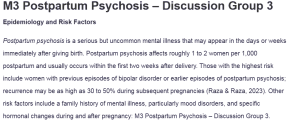M3 Postpartum Psychosis – Discussion Group 3
Epidemiology and Risk Factors
Postpartum psychosis is a serious but uncommon mental illness that may appear in the days or weeks immediately after giving birth. Postpartum psychosis affects roughly 1 to 2 women per 1,000 postpartum and usually occurs within the first two weeks after delivery. Those with the highest risk include women with previous episodes of bipolar disorder or earlier episodes of postpartum psychosis; recurrence may be as high as 30 to 50% during subsequent pregnancies (Raza & Raza, 2023). Other risk factors include a family history of mental illness, particularly mood disorders, and specific hormonal changes during and after pregnancy: M3 Postpartum Psychosis – Discussion Group 3.
Comorbidities
Comorbidity of postpartum psychosis with severe mood disorders is expected, with bipolar disorder being the most frequent, followed by schizophrenia (Raza & Raza, 2023). Women with these disorders may present with increased symptomatology postpartum, including mood swings, paranoia, or even delusional thinking. Some of the PPP patients may also have superimposed anxiety disorders or substance use disorders, further complicating the diagnosis and complicating treatment.
Treatment Options
The treatment of postpartum psychosis involves immediate psychiatric intervention because there is a risk to both the mother and the infant. First-line treatments include antipsychotic medications and mood stabilizers, often alongside benzodiazepines for anxiety or agitation. For severe cases, hospitalization may be considered, especially in cases of suicidal or homicidal thoughts by the mother.
Another option for severe cases not responsive to other treatments is electroconvulsive therapy (ECT). Psychotherapy, especially cognitive-behavioral therapy, may help supplement recovery after acute symptoms have subsided (Chaitra Jairaj et al., 2023).
Prevention and Practice as a PMHNP
Prevention of postpartum psychosis includes early screening for mental health disorders, especially for those with a history of psychiatric illness. This includes educating patients to recognize the early signs of depression or psychosis, such as mood swings, hallucinations, and irritability (Raza & Raza, 2023). Close monitoring over the postpartum period, especially for those with a history of psychiatric illness, may prevent the worsening of symptoms and thus decrease risks of suicide and filicide.
I would include this screening tool, using the Edinburgh Postnatal Depression Scale, as a Psychiatric Mental Health Nurse Practitioner to educate patients on how to engage in coping strategies and seek support systems. This will also help remove the stigma associated with mental health problems through open discussions regarding mental health before and after giving birth.
References
Chaitra Jairaj, Seneviratne, G., Veerle Bergink, Sommer, I., & Dazzan, P. (2023). Postpartum psychosis: A proposed treatment algorithm. Journal of Psychopharmacology, 37(10). https://doi.org/10.1177/02698811231181573
Raza, S. K., & Raza, S. (2023, June 26). Postpartum Psychosis. National Library of Medicine; StatPearls Publishing. https://www.ncbi.nlm.nih.gov/books/NBK544304/
ORDER A PLAGIARISM-FREE PAPER HERE
We’ll write everything from scratch
Question 
On June 20, 2001, Andrea Yates horrified the nation when she confessed to drowning her five young children in the bathtub of their suburban Houston home. Andrea, who was 37 years old at the time, suffered from severe postpartum depression, postpartum psychosis and schizophrenia.
In you initial post, discuss the epidemiology of post partum psychosis, including incidence rates, risk factors, comorbidities and treatment options. Also include ways in which you think this illness can be prevented including ways to reduce the risks for suicide and filicide. Include how you will incorporate this prevention into your practice as a PMHNP. Include references. PLEASE ANSWER ALL QUESTIONS. THANK YOU.

M3 Postpartum Psychosis – Discussion Group 3
Client’s Notes:
- Hello, it doesn’t have to be a full page. I just need it written like a discussion post with all the questions answered. Thanks
Resource:
- DSM-5-TR text